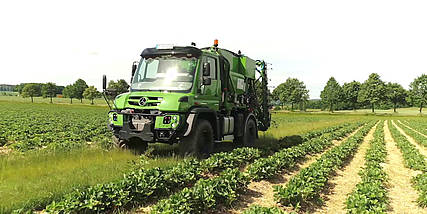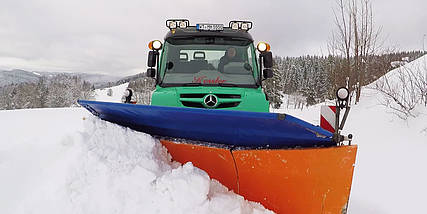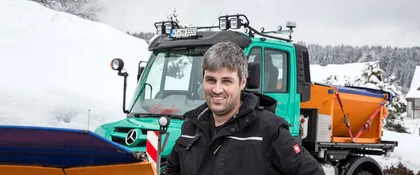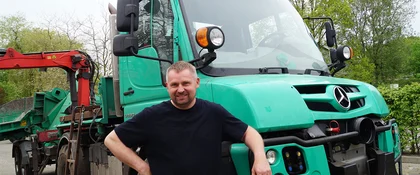The day starts while everyone else is still sleeping.
He has been at the wheel since 4 in the morning. Owing to the heavy snowfall, he has driven his two assigned routes several times, clearing the snow and spreading plenty of salt. The two routes the selfemployed contractor is assigned to cover are lengthy, and it's his job to make sure they stay clear and safe to drive on. The first route heads from the B 500 through Raitenbuch to Lenzkirch. Metzger's other route is equally long, starting in the settlement of Schluchsee, on to Faulefürst, and then through Grünwald, at an altitude of 1050 metres, before joining the B 315. "That's 40 kilometres of road to clear, meaning I have easily covered 200 kilometres by noon," he reports. He has had to top-up the salt tank in-between runs. Metzger has set the salt spreading rate on the rear-mounted spreader to 16 grams per square metre, to deal with surface freezing on the road. The cold and the snow lying on the surface were not too extreme, and so quick and easy to deal with. "When the ice is densely packed on the road, it can take more than 30 grams to thaw it. And if you set the maximum rate of 40 g/m², the entire two cubic metre capacity of the rear-mounted tank is obviously soon gone."
The versatility of the Unimog assures full order books.
Johannes Metzger, Kommunaldienst Metzger
Recent winters have been milder – but that is all changing.
The last two winters necessitated no more than 50 days of winter road clearing work in total. And it took barely four hours to get the roads back to condition. But things might change again – who knows.
"The winter before was different again. We had 80 to 100 days' work. Some years it's been even more. And when it snowed during the evening or at night, it was often necessary to be out clearing and spreading until as later as 10 o'clock." But winter road clearing work doesn't just involve sitting in the cab. There are lots of ancillary jobs to be doing – clearing ice from buildings and driveways, and ensuring safety in all weather conditions. "It is also important to clear away walls of snow at the roadside using the snow-blower. And snow nets need to be installed on steep slopes. Last but not least, when the winter eases we have to repair any damage caused by our clearing work, and remove all the snow nets and salt boxes again." The contractor is not currently earning a great deal from his winter service work. That's also connected to the conditions in the last two winters however. Metzger regards keeping the roads clear as a top-up to the jobs that he and his staff of around a dozen people are busy with during the rest of the year, and which make the business profitable.
Although Metzger also operates other vehicles in addition to the Unimog, the 272 horsepower U 427 handles two main tasks along-side winter road clearing. One is transporting machinery by towing a low-loader. The other is mulching and routine mowing, starting after the winter work in late April or early May. For three years, between 2006 and 2009, Metzger did not have a Unimog. He had sold his U 1600, and tried to handle all his work, including transporting small machinery, using forestry tractors. It was often more difficult, and took a lot more time, with more effort and complex operations involved. He soon realised what he was missing.














